Prev Page--Geologic History || Next Page--Minerals
Kansas rocks
In 1541 the Spanish explorer Coronado made the first European observation about Kansas geology--there was no gold. Since that time rocks and minerals have played an integral part in the state's history. The earliest residents of Kansas, American Indians, used native flint to fashion their arrowheads and spearpoints; they used chunks of native sandstone to grind their grain; they even mined native clay to make their pottery. The first white residents, moving into Kansas 300 years after Coronado, quarried limestones to build their houses and dug coal for heating and cooking. By the turn of the century, Kansans were mining everything from salt to gypsum, lead and zinc, oil and natural gas, and even ground water for irrigation.
In short, Kansas residents have long been interested in their state's geology. That is partly due to geology's economic importance. Rocks are the source for the multibillion dollar mineral industry in Kansas. Other Kansans are interested in rocks and minerals because of their intrinsic beauty, their appearance. The following chapter describes Kansas rocks: where they are found, how they were formed, what they are composed of, and how we use them today. To begin, we must answer a simple question: what is a rock?

A rock is any naturally occurring mass that forms a part of the earth's crust. Such a mass may consist of sediments and particles (sand, gravel, clay, or volcanic ash, for example) as well as solid material (limestone, sandstone, granite, etc.). A rock generally is composed of one or more minerals. Rocks occur in three main types, each of which was formed in a different way. These types are igneous, sedimentary, and metamorphic rocks.
Igneous rocks have been formed by the cooling and hardening of molten rock material. Igneous rocks therefore are those that have been heated to melting temperatures, forming magma, and then have cooled and hardened or solidified, as black cindery rock is formed by the cooling of lava. Some rocks have been formed by slow cooling of molten materials beneath the surface of the earth. This slow cooling allows time for relatively large mineral crystals to form, and the resulting rocks are called "coarsely crystalline." Rocks that have cooled rapidly on or near the surface of the earth do not have large crystals and are said to be "finely crystalline" or "glassy."
Sedimentary rocks are formed by wearing down and dissolving other rocks into small bits or particles of various sizes and by later deposition or laying down of these particles. Such deposits, made of the broken-down substance of preexisting rocks, are called clastic rocks. Two other important varieties of sedimentary rocks exist-chemical sediments (which are nonelastic) and deposits of organic origin. The chemical deposits include gypsum, salt beds, some limestone, some quartz-containing rocks such as cherts, some iron ores, and some carbonate spring deposits such as travertine. The organically formed deposits include many limestones, diatomaceous earth, many iron ores, and coal.
These deposits may be laid down on the sea floor, along stream and river valleys, in lakes or ponds, on the land surface by the action of wind or gravity, and around the edges of and under glaciers. When first deposited, these sediments commonly are loose or unconsolidated, but many of them are hardened into solid rocks by the weight of materials above them or by the cementing action of mineral substances deposited between the grains.
Clastic sedimentary rocks are named according to the size of the particles they contain. Loose sediments in which the grains are very fine may be silt, mud, or clay. Particles slightly larger than clay size are called silt; those larger than silt are called sand; and so it goes from pebbles, to cobbles, to boulders. Of course, the sizes may be mixed, and clays and sands may be found in the same deposit with boulders, but the rock is named for the particle size that is predominant.
Metamorphic rocks are those formed by change in igneous or sedimentary rocks. This change, or metamorphism, is the result of great heat, pressure, or action of some usually hot mineral solution. Through metamorphism, limestones become marble, shales become slate, and sandstones become quartzites.
Of the three main types of rocks, sedimentary rocks are by far the most common in Kansas. In fact, nearly all the surface exposures of the state consist of this type. The exceptions are several small areas of igneous rocks in Riley County and two areas of igneous and metamorphic rocks in Woodson County. Many pebbles and boulders of igneous or metamorphic rocks are found in Kansas, but they are not native to the state. They were formed elsewhere and brought to Kansas by ice or water and now are considered parts of sedimentary deposits.
All rocks on or near the surface of the earth are undergoing weathering. This weathering causes changes in the rock and a breakdown into smaller fragments. It may be caused by changes in temperature; by chemical action between the rock minerals and the air, ground water, or plants; or by other factors. The effects of weathering can be seen on the surfaces of rocks that have been exposed to the atmosphere. The weathered surfaces commonly have a color different from that of unweathered or fresh surfaces, and one must be very careful to find the true color of the unaltered rock beneath the weathered outer surface.
Sedimentary rocks
Limestone and dolomite
Limestone and dolomite are two very closely related rocks. The former, in a pure state, consists of grains and crystals of the mineral calcite, and the latter of the mineral dolomite (which is calcite with some magnesium added). Thus the term dolomite is used for both the mineral and the rock.
Calcite consists of calcium carbonate and is one of the most common minerals known. The mineral dolomite is made of calcium magnesium carbonate and also is fairly common. These two minerals are commonly found together in the same deposits, and whether the rock is classed as a limestone, a dolomitic limestone, or a dolomite depends on the proportion of each mineral. The two minerals can be told apart by the way dilute hydrochloric (muriatic) acid reacts on each. Cold dilute hydrochloric acid will bubble and fizz when it is put on limestone. In order to react in the same manner with dolomite, the hydrochloric acid must be heated or the dolomite must be powdered.
Fort Riley Limestone Member and Underlying Limestone Formations in Geary County.
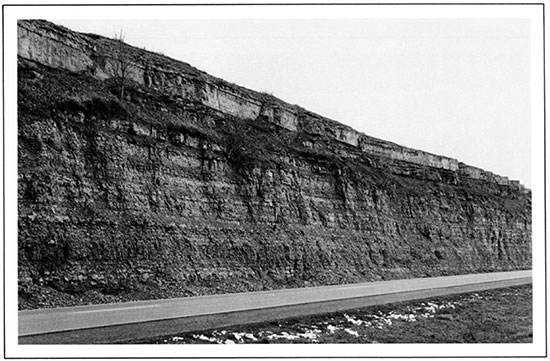
In surface exposures, dolomite is found in southeastern Kansas and in certain rocks of Permian age, which occur in the central part of the state. Limestone, on the other hand, is very widespread. Many of the rocks of eastern Kansas consist of nearly pure limestones. In the central and western parts of the state, limestone is not quite so common, although extensive deposits of chalk, a type of limestone, are found.
Limestone
Pure limestones are white or almost white. Because of impurities such as clay, sand, organic remains, iron oxide, and other materials, many limestones exhibit different colors, especially on weathered surfaces. Limestone may be crystalline, clastic, granular, or dense, depending on the method of formation, and crystals of calcite, quartz, or dolomite may line small cavities or geodes in the rock. Chert balls or nodules and stringers are common in limestone layers, especially in the Florence limestone of Permian age, which crops out in the Flint Hills area from Marshall County southward to Cowley and Chautauqua counties.
Most limestones are marine deposits, but some are formed in lakes, in rivers, and on land. Kansas has many different varieties of limestones as spring deposits or as caliche beds. These are described separately as to occurrence and origin.
Limestone is used in making Portland cement, and the alternating limestone and shale beds of eastern Kansas are a good source of the two chief ingredients of the cement. Portland cement is manufactured in Allen, Montgomery, Neosho, Wilson, and Wyandotte counties. Limestone also is used in the construction of roads and railroads, as a building stone, as a soil fertilizer, as a source of lime in chemicals, and in many other ways. Chalk, one type of limestone, is an ingredient in paints and polishes.
Cement Plant near Humboldt in Allen County.
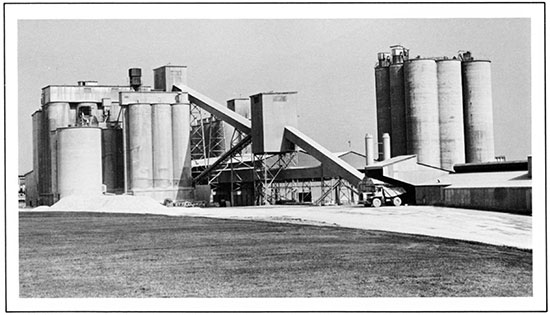
Limestones consisting mainly of animal shells
The shells of many animals, those that live either in the sea or in freshwater, consist of calcite and the mineral aragonite, which also is composed of calcium carbonate. When the animals die, their shells are left on the ocean floor, lake bottom, or river bed where they may accumulate into thick deposits.
Crinoidal limestones--Crinoids are sea animals having long stems and cuplike bodies that look so much like flowers that they are called sea lilies. The stems break into small, disc-shaped fragments. Some limestones of the Pennsylvanian and Permian rocks of Kansas contain so many of these stem fragments that the term crinoidal limestone describes them well. These are found extensively in eastern Kansas. The Cretaceous Niobrara Chalk in a few localities in western Kansas contains beautiful specimens of stemless crinoids, in which both the bodies and the long arms are excellently preserved.
Fusulinid Limestones--One group of the single-celled animals called Foraminifera is known as the fusulinids. These small animals, whose shells look like grains of wheat, were abundant during the Pennsylvanian and Permian periods, and many of the rocks of those ages are almost solid masses of fusulinid shells. Both limestones and shales contain multitudes of these animal shells.
Reeflike Limestones and Shell Limestones--Many limestones contain the shells not only of crinoids and fusulinids, but also of corals, brachiopods, clams, oysters, bryozoans, and other forms. Some of the animals lived in colonies, and the remains formed lens-shaped or elongate deposits, which sometimes grew to several hundred feet in thickness and hundreds of miles in length. However, those in Kansas were much smaller. Reeflike bodies in eastern and southeastern Kansas were formed by limy mud trapped by leaflike blades of marine algae. (One limestone formation in Labette County has a reeflike structure at least 12 miles long and 13 feet thick.) Small colonies or groups of fossil shells in some formations measure only a foot in diameter.
Limestones formed partly by chemical processes
Calcium carbonate is more soluble in water that contains carbon dioxide than in pure water, and when the carbon dioxide is removed for any reason, the calcium carbonate falls out of solution and settles to the bottom. Plants remove carbon dioxide from the water by using it in their food. When the water is heated, evaporated, or merely stirred, the carbon dioxide content is decreased and limestone is deposited.
Algal Limestone--Algae are primitive plants; most seaweeds and pond scums are algae. They may live in seawater or freshwater. Like all plants, they use carbon dioxide to manufacture food and when the carbon dioxide comes from water containing calcium carbonate, the calcium carbonate may be precipitated. The limestone that results commonly takes on the form of algae or groups of algae and may form irregularly shaped, banded structures. Approximately half the limestones of the Pennsylvanian and Permian rocks of eastern Kansas are at least partly formed by algae. Particularly good exposures can be seen in Johnson and Brown counties and in the Flint Hills.
Oolitic Limestones--Oolites are small rounded particles or grains, so named because they look like fish eggs. Oolites commonly are formed by layers of material, usually calcite, that have been deposited around some tiny particle such as a sand grain or fossil fragment and then formed by rolling back and forth in quiet waters. When the grains formed by this method are more than two millimeters in diameter (about the size of the head of a pin), they are called pisolites.
Many limestones in Kansas, particularly limestones of Pennsylvanian age, contain oolites. They are especially noticeable in Johnson, Miami, Linn, Bourbon, and Labette counties, and near the towns of Independence and Cherryvale in Montgomery County. Rocks of Permian and younger age in Kansas do not contain many oolites; hence, most outcrops of oolitic limestone are found in the eastern third of the state. Some of the oolites may be of algal origin.
Chalk--Chalk is a variety of limestone that probably was formed in either or both of two ways. Part of the limestone is the accumulation of shells of the small, single-celled animals called Foraminifera. The rest of the limestone resulted mainly from chemical precipitation of calcium carbonate. Pure chalk is white, but it may be stained with iron oxide or other impurities. It is a soft, porous rock that crumbles easily.
In the Upper Cretaceous rocks of western Kansas, a chalk and chalky shale formation, the Niobrara, crops out in an irregular belt from Smith and Jewell counties on the northeast to Finney and Logan counties on the southwest. In color the rock is gray to cream but weathers white, yellow, or orange. The average thickness of the entire formation including pure chalk and chalky shale is about 600 feet.
Chalk is abundant in west-central Kansas and is as representative of Kansas geology as the sunflower and the cottonwood tree are of the state's plant life or the meadowlark and buffalo are of the animal kingdom. Furthermore, chalk has been a part of the Kansas region not for centuries but for thousands of centuries.
Kansas chalk beds are known the world over for the reptilian and other vertebrate fossils found in them, and they are equally famous for the pinnacles, spires, and odd-shaped masses formed by chalk remnants in many localities. Particularly notable are Monument Rocks and Castle Rock in Gove County and the chalk bluffs along the Smoky Hill River in Logan, Gove, and Trego counties.
Castle Rock in Gove County.
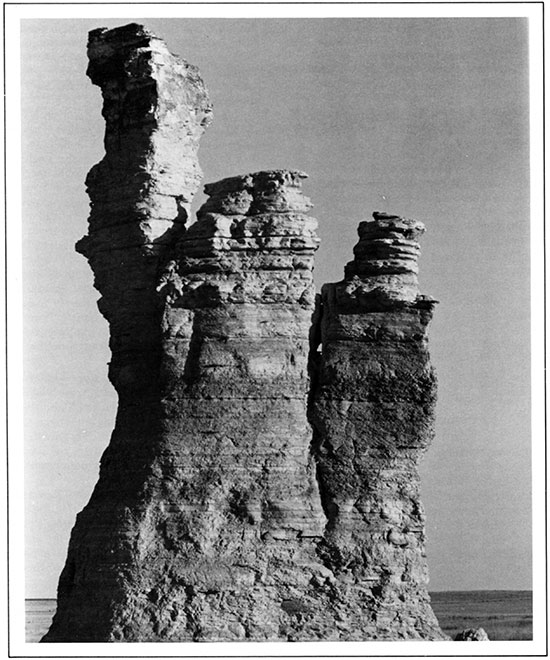
Diatomaceous Marl--This rock is important not because of the calcium carbonate it contains, but because of the diatoms: tiny, single-celled creatures that have characteristics of both plants and animals and have outer shells of silica. When diatoms die, their shells settle to the bottom of the lake or sea and accumulate. In the Ogallala Formation of Wallace and Logan counties are deposits of white marl containing many shells of these small diatoms. The deposits can be seen plainly from a distance where they crop out along the south side of a valley for about four miles. Outcrops of diatomaceous marl also are found in Meade and Seward counties and elsewhere in western Kansas. The marl can be mined and used for filtering water or other solutions and as a filler in paints and other products.
Travertine--Travertine is formed along streams, particularly where there are waterfalls, and around hot or cold springs. Calcium carbonate is deposited because evaporation of the water leaves a solution that is supersaturated with chemical constituents of calcite. Travertine is a banded and more or less compact variety of limestone. A good deposit of travertine in Kansas was once found around Waconda Spring in Mitchell County, where the minerals in the spring water gradually built a hill of travertine 42 feet high and 300 feet in diameter. The travertine of Waconda Spring, now covered by the waters of Glen Elder Reservoir, was formed chiefly of the mineral aragonite, an unusual form of calcium carbonate.
Waconda Spring, Now Covered by Glen Elder Reservoir, in Mitchell County.
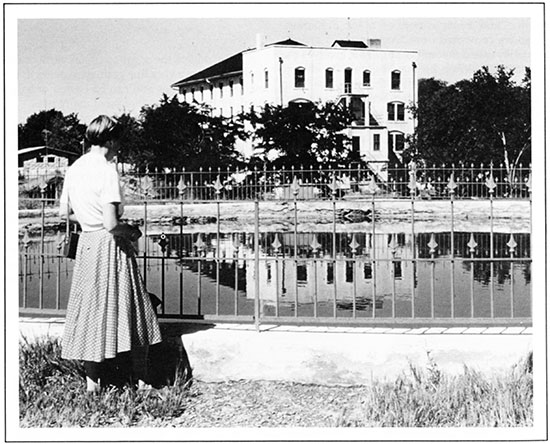
Tufa, a porous or cellular variety of travertine is found near waterfalls. Such deposits have been reported in Riley, Wabaunsee, Geary, Meade, and Butler counties, and they occur in many more places.
Caliche--Caliche is a type of calcite-cemented sandstone that forms in the soils of dry regions. It is generally impure (clayey, silty, sandy) and fairly soft, although very old caliche may be extremely hard. Some caliche consists only of small nodules, such as the Loess Kindchen in wind-blown silt, but also occurs as a continuous bed that can be traced for many miles. The pisolitic limestone near the surface of the High Plains in western Kansas is such a bed. This dense limestone (formerly called "algal") has a distinctive structure and can be recognized by its pinkish color, banded appearance, and concentric areas. It was formed after the close of Tertiary time when the climate was drier than it is now.
Dolomite
Dolomites are fine- to coarse-grained rocks that, in the unweathered state, are generally gray to light colored. On weathering they may become buff or tan because of impurities that commonly consist of iron within or between the dolomite crystals or of small amounts of pyrite, siderite, or marcasite. Dolomites may be formed by the same processes as limestones such as chemical precipitation, or occasionally by breakdown and redeposition of older dolomites. They also are converted from limestone by a process appropriately called dolomitization. This involves the replacement of calcium by magnesium. The change may take place before or after the rock has been solidified and is caused by the action of seawater, ground water, or hot mineral water.
Among the surface rocks of Kansas, dolomite is found chiefly in three formations in the central and southern part of the state. One formation (the Stone Corral dolomite) has a maximum thickness of about six feet in Rice County. Another formation (Day Creek Dolomite), found in Clark County, is about two and a half feet thick. These formations were deposited in the enclosed evaporating basin of the Permian sea, as evidenced by the presence of much anhydrite, an evaporite deposit in the subsurface rocks. A thick dolomite also is found in the southern Flint Hills. Dolomite is used in ways similar to that of limestone.
Mortar Beds in the Ogallala Formation at Scott County State Lake.
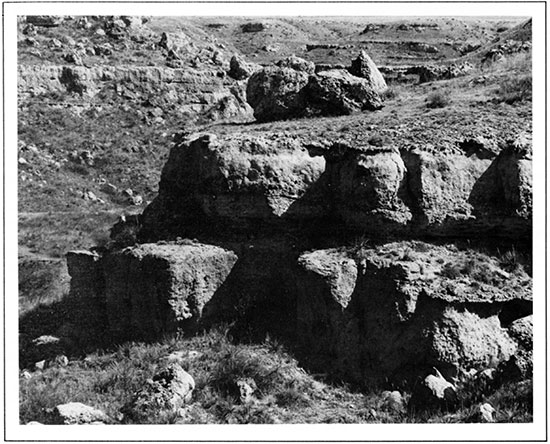
Clay
Clay is one of the most common earth substances in Kansas. It is a very fine grained material that can be molded into shapes and can be heated or baked into hard, resistant forms that have many uses.
The particles in a clay deposit are so small (less than 1/256 mm in diameter) that they cannot be seen without a microscope. Formed by weathering and breaking down of solid rocks, these particles may then be carried to some quiet body of water, such as a lake or pond or the sea, where they settle to the bottom. Clay particles are made of several types of minerals, most of which are small, platy flakes. The deposits formed may have almost any color--white, gray, black, red, yellow, buff, or green. Many clay deposits contain impurities such as sand, calcium carbonate (the chemical compound that forms limestones), and iron minerals.
Clays and shales are used in making bricks, tiles, pottery, chemical ware, furnace linings, and lightweight concrete aggregates. In Kansas, the best deposits of refractory clays--those that can withstand firing at high temperatures--are in rocks of Cretaceous age in Washington, Clay, Cloud, Lincoln, Ottawa, Ellsworth, and other central Kansas counties. Thousands of tons of these Cretaceous clays are used each year in the manufacture of light-colored face bricks, and smaller amounts are used in making pottery.
Bentonite is a clay formed by chemical alteration of volcanic ash. When water is added to it, bentonite may swell to as much as 15 times its original bulk and form a milky cloud in the water. Most Kansas bentonites swell, when wet, to less than three times their original volume. Some bentonites can be identified by their waxy or soapy appearance. Many deposits are known in western Kansas, the thickest in Phillips County. Very thin layers can be seen at McAllaster Buttes in Logan County, and a thin layer occurs in places above the volcanic ash in the Calvert ash mine in Norton County. Other thin deposits are interbedded with the chalks and chalky shales in western Kansas, and a particularly pure bed is located in Clark County.
Underclay is a clay that occurs under a coal bed or under a coal horizon. This clay, generally characterized by lack of bedding, commonly contains fossilized roots of plants and other carbonaceous material. Underclay is present under many of the coal beds in southeastern Kansas; in Cherokee County it is utilized in the manufacture of buff brick. Some of the underclays are suitable for firing at high temperatures.
Brick Plant near Kanopolis in Ellsworth County.
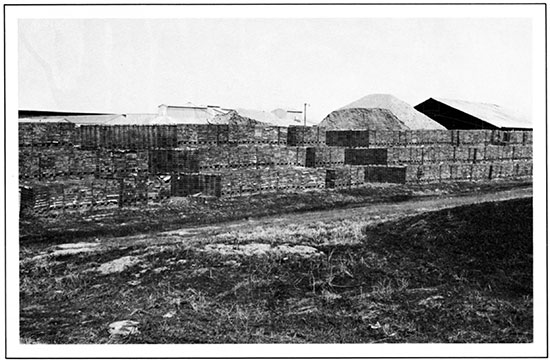
Shale
A hardened, compacted clay or silty clay that commonly (but not in every case) breaks along bedding planes is called shale. The particles that make up a shale are too small to be seen without a microscope. Many shales have a leaflike bedding and weather into thin slabs or plates, some of which are no thicker than paper. When shales weather, they form clays or muds.
Shales and clays are easily eroded, or worn away. Consequently the best exposures are found beneath ledges of harder, more resistant rocks, such as limestones and sandstones. Most shales are soft enough to be cut with a knife and are either brittle or crumbly. They are usually gray, but black, green, red, or buff shales are common. Many contain nodules of pyrite, selenite (gypsum) crystals, or concretions of various forms, which are described in other sections of this booklet.
Shale and clay together make up about 80% of the sedimentary rocks of the earth's crust. In Kansas they are very common. Dark-gray to black Cretaceous shales, hundreds of feet thick, are common in the west-central part of the state. Much of the shale found in Pennsylvanian rocks is interbedded with layers of limestone. Shale in eastern Kansas has been used for many years in making bricks. When heated its color changes to well-known "brick-red." Shale also is used mixed with limestone for making Portland cement.
Dark-Black Shale in the Fort Scott Formation in Crawford County; Round Features are Marble-Sized Nodules of Phosphate.
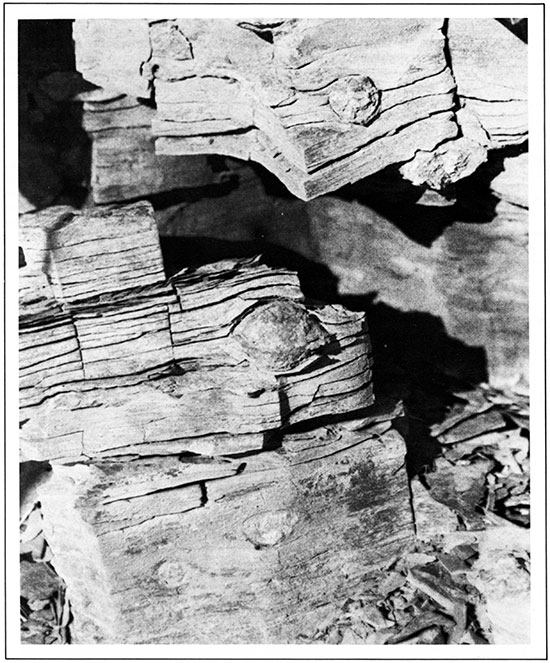
In certain eastern counties, particularly Labette and Neosho, are several black, platy shales that contain large amounts of organic matter. Some are so rich in this material that thin slivers may be set on fire with a match; they are a form of oil shale.
Some black, very thin bedded shales often are called slate because they have the same color as many slates and because they break into thin, hard, platy sheets. Slate, however, is a metamorphic rock, formed when shale is put under great heat and pressure, and no true slate occurs naturally in Kansas.
Silt and siltstone
Silt is a common sedimentary rock composed of tiny particles smaller than sand size yet larger than clay size (1/16-1/256 mm). It is found in stream deposits and lake beds, but it occurs chiefly as a wind-blown deposit, called loess, which mantles the High Plains of western Kansas and in thick deposits along the bluffs of the Missouri River in northeast Kansas. It occurs to some extent in many other counties in the state. The loess is typically a yellowish-buff porous silt that crops out with steep faces along hillsides and valley walls. Much loess contains white or cream-colored concretions an inch or two in diameter, which are composed of calcium carbonate and have been called Loess Kindchen (little children of the loess). Small, white shells of snails also may be found in the loess.
Some of the finest and thickest soils in the world are formed in the upper part of thick deposits of loess. As wind moves small particles only, a soil developed in a deposit of this kind is free from boulders and pebbles. Loess deposits have been built up by successive dust storms. More than 90% of the soil in Thomas, Sherman, Cheyenne, Greeley, Hamilton, Wichita, Scott, Lane, and other western counties consists of the upper part of these loess deposits. In Ford, Grant, Gray, Haskell, Kiowa, Meade, and Stevens counties in southwestern Kansas, loess deposits also are widespread. In short, those dust storms past and present, which we consider as damaging to the state, have helped to give us one of our most valuable resources--a rich, fertile soil.
Loess Canyon in Cheyenne County.
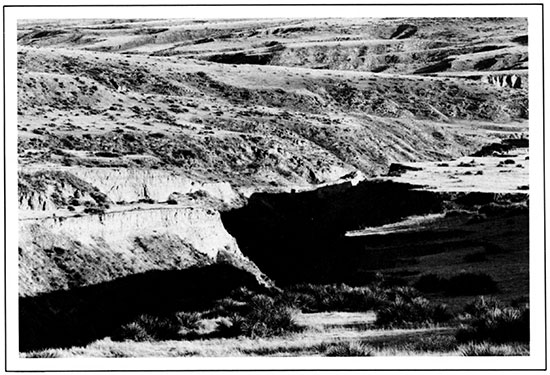
In northeastern Kansas a very rich soil has developed on the loess, especially in Brown and Doniphan counties and along the bluffs of the Missouri River as far south as Kansas City. This loess is present on the hilltops and slopes and in the valleys. It is thickest in a strip about two miles wide bordering the Missouri River and in Doniphan County in the area of the big bend of the Missouri River. On the river bluffs the loess is 60-100 feet thick. Farther from the river it may be no more than five feet thick. This loess of northeastern Kansas is the fine material ground by the advancing ice sheet and deposited on the flood plains by streams coming from the melting glaciers. The material was later worked over by winds. It is thought that most of the loess in northeastern Kansas was laid down more than 50,000 years ago.
Consolidated or compacted silt is known as siltstone. This rock may be found as thin, slabby beds in many of the Pennsylvanian formations of eastern Kansas. Many siltstones and fine sandstones contain layers rich in tiny flakes of mica which glitter in the sun. The mica is concentrated along the bedding planes where the rocks break easily.
Sands and sandstone
Sands are loose, unconsolidated rocks having particle sizes between those of silt and pebbles (1/16-2 mm). When held together by chemical cement or by clay, they are called sandstones. These rocks result from the breaking down or weathering of older rocks and from the transportation and sorting of rock fragments by moving water or by wind.
Sand is found abundantly in Kansas. Most of it consists of grains of quartz, but some of it contains a large amount of feldspar. Sand also contains traces of rare igneous and metamorphic minerals formed outside the state and carried in, along with the other grains, by running water. Sand occurs almost everywhere along the large stream valleys in the state; in regions of old glacial drainage or outwash, particularly near Atchison in Atchison County; or in great deposits of wind-blown sand in dunes along the Arkansas River in Hamilton, Kearny, Finney, Gray, Ford, Kiowa, Edwards, Pratt, Pawnee, Stafford, Barton, Clark, and Reno counties. Also loose sand is found in parts of the Tertiary Ogallala Formation along old river deposits in western Kansas.
Outcrop of Sandstone in the Dakota Formation, Ellsworth County.
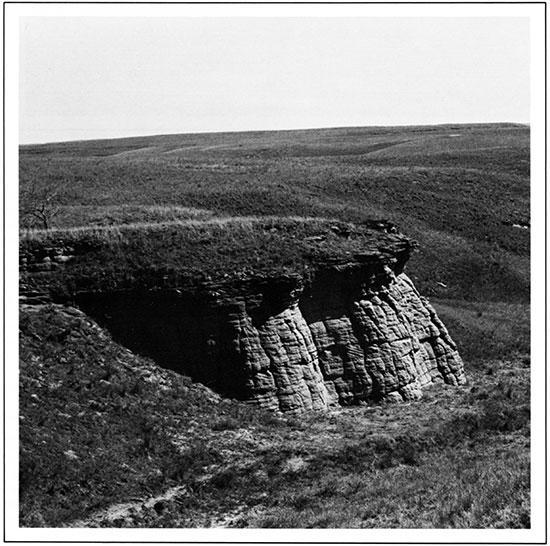
Sandstones, like sand, consist largely of quartz grains, but sandstones are held together by some natural cement or matrix such as calcium carbonate, iron oxide, silica cement, or clay, and the rocks can be classified according to the type of cement.
Sandstone occurs interbedded with shale and limestone in the eastern part of the state. In Pottawatomie, Wabaunsee, Nemaha, Brown, Jackson, Riley, Shawnee, Lyon, Greenwood, Cowley, and Chautauqua counties, it occurs as channel deposits cutting through shale and limestone. Most of this sandstone is buff or brownish in color, and some is cemented by iron oxide. Sandstone of the Dakota Formation is present in the Smoky Hill region in north-central Kansas in a wide belt extending from Rice and McPherson counties to Washington County. Much of it is cemented by dark-brown iron oxide and is so resistant to erosion that it caps steep hills. This Dakota sandstone also forms the giant concretions at Rock City near Minneapolis and at Mushroom Rocks State Park.
Sandstone Concretions at Rock City, Ottawa County.
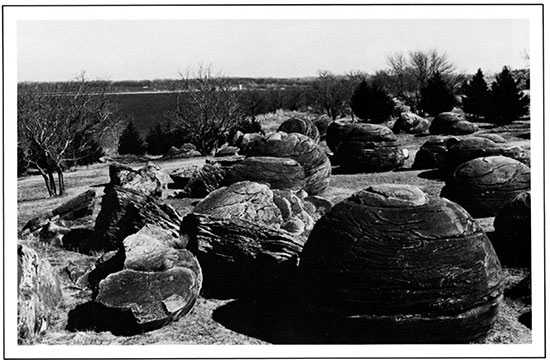
In the same region are some small areas where the sandstone is cemented by calcite (calcium carbonate) in crystals so large that wide areas of the rock reflect light in a manner known as "luster-mottling." This rock is sometimes called "quartzite" because it is very hard, but it is not a true quartzite. True quartzites are cemented by a form of quartz commonly called silica. Soft, crumbly sandstones of Cretaceous age form cliffs and box canyons in small areas in Kiowa, Comanche, and Clark counties. Iron-oxide cement in this sandstone (the Cheyenne) produces a wide range of colors, including yellow, various bright reds, purple, and brown. Bright-red, fine-grained sandstones of Permian age crop out in picturesque canyons in south-central Kansas.
At the surface, the most common rock in the Ogallala Formation of Tertiary age in western Kansas is sandstone cemented by very fine grained calcium carbonate. This rock is porous and the particles are poorly sorted. It looks much like concrete and is popularly known as mortar beds. Good outcrops of the mortar beds occur at Scott County State Lake and cap Point of Rocks in Morton County. Hard, dense, gray-green sandstone also is found in some parts of the Ogallala, especially in southern Phillips County, but also in Graham, Hodgeman, Ness, Norton, Rawlins, Rooks, and Smith counties. This rock has an opal cement and therefore is called opaline sandstone or ortho-quartzite. It is occasionally used as a building material, and good examples are present in a Hill City park.
Ogallala Formation in Rawlins County.
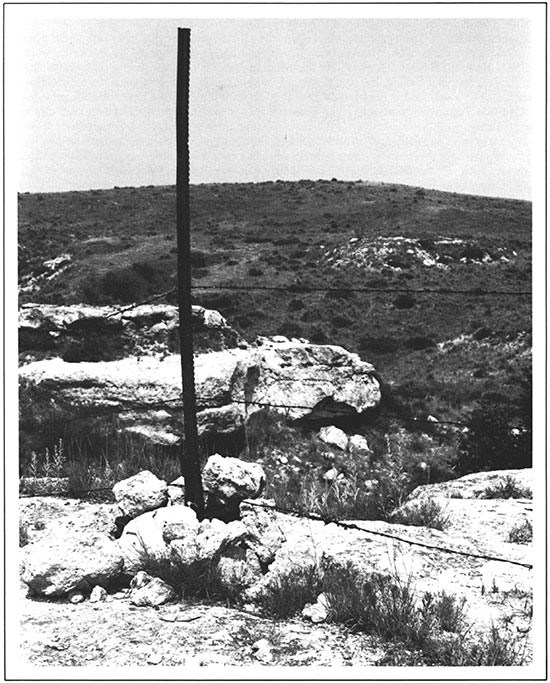
Sands and sandstones are used in making glass, as building materials (mainly in concrete), as filters, and for making molds in foundries. The supply along the larger rivers is abundant, although some of the deposits are impure.
Gravel and conglomerate
The term "gravel" in lay terms usually means a rock composed of particles ranging from sand to pebble size or larger (2-64 mm). Gravel deposits vary greatly in mineral composition, size, shape, and color. Glacial-outwash gravels occur in northeastern Kansas. Stream gravels underlie the High Plains in the western part of the state. In the Flint Hills section and in southeastern Kansas are gravels that consist mainly of just one mineral, chert or flint, which weathered from Paleozoic limestones. These brown, hard, resistant gravels commonly cap the uplands in Anderson, Cowley, Elk, Greenwood, Lyon, Morris, Wabaunsee, Geary, Riley, Pottawatomie, and Marshall counties.
The gravels from the continental glaciers, and those gravels in the western part of the state that came from the Rocky Mountains, are excellent sources of many rocks and minerals that are not found in place in the sedimentary rocks cropping out in Kansas. Among these are feldspar, agate, clear transparent quartz, native copper, granite, basalt (a dark, fine-grained igneous rock), and other igneous rocks.
Conglomerate is a hardened, generally cemented gravel and, like sand, silt, and clay, has been formed by the breaking down of older rocks and by later redeposition. Commonly it is found interbedded with layers of sandstone. It also occurs at the base of many Pennsylvanian formations, as for example near the town of Baldwin in Douglas County. Local small areas of hard conglomerate are found in many gravel pits in Tertiary and Pleistocene deposits. Conglomerate and gravel are used in making concrete, in surfacing roads, and as railroad ballast.
Boulder clay
Boulder clay is an extremely varied deposit consisting, as the name suggests, of particles of all sizes from large boulders to clay. It is a typical product of glacial action and is often called glacial till. Therefore, boulder clay is found only in the northeastern section of Kansas, the only part of the state that has been glaciated. Boulder clay forms low, rounded, rolling hills covered with loess, soil, and vegetation. Consequently very few good outcrops occur. The boulders and pebbles which have been carried by ice from both local and distant rocks are of many different types.
They include limestone, sandstone, quartzite, granite, basalt, and many others. The quartzite boulders are hard, red rocks and their nearest source is southeastern South Dakota, more than 400 miles away. Most of these rocks have been deeply weathered since they were left by the melting of the ice sheet. Often they have been weathered so much that a "hard" granite can be crumbled with bare hands. Some of the quartzite, however, is so hard and well preserved that it cannot be broken with a hammer. Upon close examination, some pebbles and boulders are seen to have been scratched and polished from rubbing against other rocks in the ice.
Glacial Erratic near Vermillion in Marshall County.
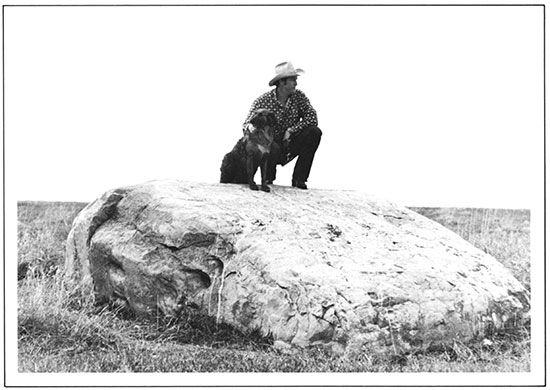
Glacial till conceals the bedrock over much of the glaciated region. This is one of the reasons that northeastern Kansas was overlooked so long in prospecting for oil and gas. However, the thick deposits of boulder clay have formed deep soils, especially good for fruit crops. Furthermore, the streams cutting their valleys into the unconsolidated glacial material have produced a type of scenery that is not found in other parts of the state.
Evaporites
Rocks formed by the evaporation of water are known as evaporites. This evaporation may take place either in shallow basins on the land or in the sea. However, the rocks that were laid down under the sea form the thicker and more widespread deposits. Kansas rocks formed in this way include deposits of gypsum, anhydrite, and common salt or halite.
Seawater contains many salts in solution. These are brought into the oceans by rivers, which are continually wearing down or eroding land surfaces and dissolving the salts. When seawater evaporates, the salts precipitate and settle to the bottom. The less-soluble compounds, those that dissolve less readily in water, are deposited first during the evaporation process. Calcium sulfate, the compound that forms gypsum and anhydrite, is among the least soluble and consequently is one of the first deposited after dolomite. Next in order of solubility and hence in deposition is sodium chloride, or common table salt.
The Permian sea, in which evaporites were deposited in Kansas, was a shallow arm of the ocean that was shut off from the main body of water by some barrier, perhaps land areas in Oklahoma and Texas. The rate of evaporation was greater than the combined inflow of water from the ocean and from rainfall and as evaporation continued, the salts of the ocean water became more and more concentrated. Occasionally more water from the ocean came into the Kansas sea, and this in turn was evaporated. Gradually thick deposits of gypsum, anhydrite, and salt were built up on the sea bottom. These were buried by later deposits of Permian age and then by younger rocks.
Evaporite deposits are described more fully under the separate mineral names gypsum, anhydrite, and halite. They are very common in Kansas, particularly in the central and western parts of the state, and they have many uses.
The evaporites formed on the land are neither so thick nor so common as those formed under the sea. However, at various places in Kansas, especially in northeastern Stafford County and near Jamestown in Cloud County, salt flats occasionally form. These result from the solution of gypsum or halite by ground water that later evaporated when it reached the surface and left the gypsum and salt deposited on or near the top of the ground. Gypsum deposited in this way looks like dark granular earth and is called gypsite or "gypsum dirt."
Gypsum Plant near Blue Rapids in Marshall County.
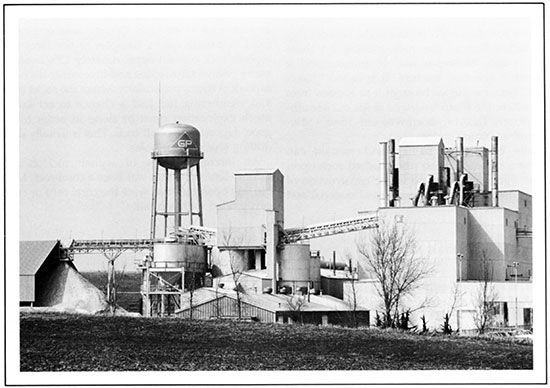
Quartzite
Quartzite is a rock consisting of quartz sandstone so thoroughly cemented with silica that the rock breaks through the grains as easily as around them. It is distinguished from sandstone not only because it breaks through the grains, but also because it cannot be scratched by a knife. Quartzites may be either metamorphic or sedimentary in origin, and the two types are so similar in appearance that in many cases they cannot be differentiated without a microscope. Kansas has small quantities of both types.
Metamorphic quartzites are caused by intense folding of the rock or by solutions from nearby igneous intrusions, or both. The only metamorphic quartzite known in Kansas is located in Woodson County, four miles west and 10 1/2 miles south of Yates Center and is probably associated with an intrusion of igneous rock in that area. The quartzite of Woodson County is a thin-bedded, slabby, hard rock of many different colors-green, gray, pink, and black. It crops out in a hillside for hundreds of feet. During the 1870's, this location was the site of an unsuccessful silver-mining rush, and many old prospecting pits can still be seen.
Sedimentary quartzite in Kansas is found locally in two Cretaceous formations, the Kiowa Shale and the Dakota sandstone, where quartzite caps hills and forms hard, resistant ledges in eastern McPherson County and in Kearny County near Hartland. The silica cement was deposited from solution in seawater during or shortly after deposition of the sand. The rock ranges in color from white to brown and light red. The green opal-cemented rock in the Ogallala Formation has been described in the section on sandstones, but it is almost as hard as a true quartzite. As opal is a form of silica, this rock may be considered a special type of quartzite. Typical quartzites, however, are cemented with quartz rather than with opal.
Quartzite boulders are common in the boulder clay of the glaciated area. The rock making up these boulders is red, brownish red, or purple, and it breaks with a splintery fracture. It is called "Sioux quartzite" because the ice brought it to Kansas from the area where the Sioux quartzite crops out-southeastern South Dakota, northwestern Iowa, Minnesota, and adjoining states.
Quartzite, because it is so hard and resistant, can be used as a railroad ballast (the crushed rock upon which the tracks are laid) and in the construction of dams. It is used in some places as road material and as building stone.
Field of Glacial Boulders South of Wamego in Wabaunsee County.
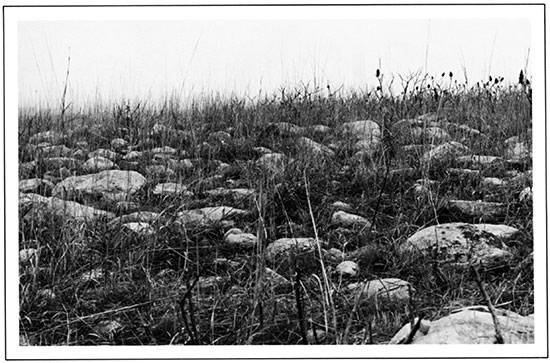
Asphalt rock
Asphalt, a solid or nearly solid organic substance composed of carbon and hydrogen, is formed as the lighter parts of petroleum evaporate and the heavy, tarry residue remains behind. Natural asphalt, that made by nature and not in an oil refinery, is found in Kansas in the pores of both limestone and sandstone. It occurs in rocks of Pennsylvanian age in the eastern part of the state and in small amounts in the Cretaceous sandstone of McPherson County. At one time asphalt rock from Linn County was quarried and used in paving roads. Samples of the Linn County asphalt rock contain approximately 12% asphalt. As many porous sandstones and limestones do not have asphalt in them, particularly where the rocks crop out and weathering has had a chance to act on them, much exploration must be done in order to find a good deposit of asphalt rock. This is usually done by drilling shallow test holes.
An interesting type of asphalt rock is a Linn County limestone that was once a coral reef. Many of the tiny openings that were the coral cells or cups are partly filled with asphalt.
Jasperoid
Jasperoid is slightly metamorphosed sedimentary rock in which the lead and zinc ores of the Tri-State mining area (a district comprising the southeastern corner of Cherokee County, Kansas, and adjacent parts of Missouri and Oklahoma) are commonly found. A gray to black mottled chert, coarser grained than ordinary chert, is the cementing material around angular pieces of the original light-colored chert.
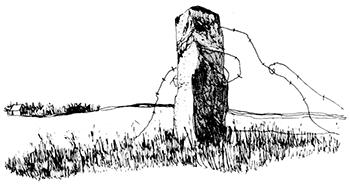
Igneous rocks
Granite
Granite is a coarsely crystalline igneous rock formed by the slow cooling of hot molten rock deep within the earth. All granite contains quartz and feldspar and a small amount of at least one of several other minerals.
The only granite native to Kansas and exposed at the surface crops out on a low hill or ridge along U.S. Highway 75, eight miles south of Yates Center, Woodson County. The granite consists largely of cream-colored to white feldspar crystals and bluish quartz. It is badly weathered, but fresh specimens may be obtained by breaking into the rock. Most of the granite that is seen at this locality is in the form of residual boulders. Probably the granite exposed here does not represent an igneous body that extends to great depth at this locality. Drilling to demonstrate tonnage of the granite revealed peridotite and metamorphosed and unmetamorphosed Pennsylvanian sediments below the surface. The granite has been age-dated as Precambrian, whereas the peridotite is Cretaceous. It is apparently a large boulder that was ripped loose at depth and carried to the surface by the eruptive force of younger igneous rocks.
Tremendous quantities of granite and granite-like rock occur in the subsurface rocks of Kansas. This granite is the "basement" rock upon which the oldest Paleozoic sediments were deposited, and it is found at depths of from 600 to several thousand feet. It is closest to the surface in Nemaha County.
Specimens of many varieties of granite and other igneous rocks are found in the boulder clay or glacial till in northeastern Kansas. Cobbles and pebbles of granite are also found in western Kansas, brought there from the Rocky Mountains by prehistoric streams.
Peridotite
Peridotite crops out in a sill-like mass about one mile long and one-fourth mile wide in southern Woodson County. Peridotite is a medium- to coarse=grained basic igneous rock, containing phlogopite mica in this area. At the surface, the rock is altered to a yellowish-gray mass of clay studded with vermiculite. Kimberlite, a form of peridotite, is found in several locations in Riley County. Kimberlite is formed much like a volcano, as igneous rock wells up to the surface from deep underground. Therefore, these rocks, like the granite, are called intrusive igneous rocks because they were forced into other rocks below the surface of the earth. In appearance the kimberlite is a soft, dull gray-green rock and is cut by thin white veins of calcite and magnetite. Kansas peridotite also contains irregular spots of hardened or altered shale. When the hot, molten igneous rock came in contact with the Paleozoic shale, or country rock, pieces of shale broke off and fell into the liquid mass. Several kimberlites also contain such minerals as ilmenite and garnet. In some places, such as South Africa, diamonds are formed in kimberlites, although no diamonds have been found in the Kansas kimberlite.
Riley County Kimberlite; Dark Specks in Rock are Garnets.
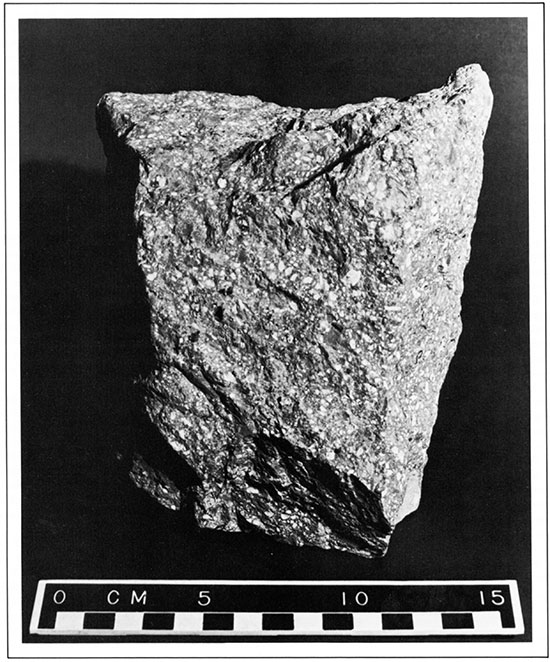
Volcanic ash
Volcanic ash, or volcanic dust (in some places called "silica," although this name is not exactly accurate), consists of tiny glass or congealed lava fragments that have been blown into the atmosphere during the eruptions of volcanoes such as Mount St. Helens. It is a type of extrusive igneous rock; that is, it has been forced out, or extruded, onto the earth's surface. Volcanic ash in Kansas is found in sedimentary deposits of Tertiary and Quaternary age. In some places it is more than 20 feet thick. Under a microscope or a hand lens, ash is seen to contain small curved pieces of glass that are the broken walls of bubbles of the lava rock that burst from the volcano. Kansas volcanic ash has about the same chemical composition as granite, but in the case of the ash, the molten rock cooled so quickly that there was not time for crystals to form. Ash can easily be distinguished from other rocks by its white to bluish-gray color. Its glassy surfaces sparkle in the sun, and its particles do not dissolve in water as do particles of limestone and chalk.
No volcanoes existed in Kansas during Tertiary and Quaternary times so a source outside the state must have been responsible for the large quantities of ash deposited here. Most of the Kansas ash was probably carried in by wind from a volcano in north-central New Mexico, eruptions in Yellowstone, Wyoming, and from Long Valley caldera in California. Once in Kansas, some of it was carried for short distances by streams and was deposited in quiet ponds, burying pond grasses and snails in the clays beneath. Ash occurs abundantly in central and western Kansas and has been found as far east as Nemaha, Douglas, and Chautauqua counties. In the past it has had many uses: in toothpastes and powders; as abrasives, cleaning compounds, and glazes for pottery; in filters; and in the manufacture of cement and road asphalt.
Volcanic-Ash Mine near Calvert in Norton County.
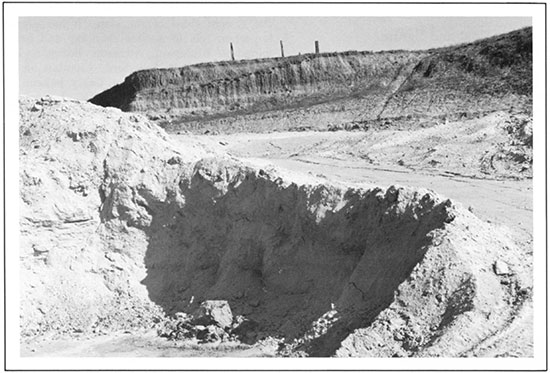
Basalt
When volcanoes erupt quietly instead of explosively, molten rock pours out in a liquid state of varying thickness depending on the silica content of the lava. The solidified material formed by cooling of the lava sometimes has a ropy appearance. It is a dark, fine-grained rock called basalt. No basalt native to Kansas occurs at the surface, but many persons have mistaken for such igneous rock some of the ropy-appearing, dark-brown sandstone of the Dakota Formation, as that on Coronado Heights in Saline County. This structure, which had nothing to do with molten rock, was caused by the chemical deposition of iron oxide in the sand.
Boulders and pebbles of basalt occur in stream deposits in the southwestern part of the state and in the boulder clay and related deposits of the glaciated region.
Meteorites
Almost everyone has seen" shooting stars." These "shooting stars," or meteors, are properly called meteorites if they reach the earth's surface. They consist of extra-terrestrial rock fragments that have come into the earth's atmosphere. The friction between the rock and the air causes the meteors and surrounding gases to glow from the heat, and it is these hot, glowing objects that we see. Most of them never reach the earth's surface because the intense heat consumes them very quickly by vaporization.
Two main types of meteorites can be identified, one easily, the other with difficulty. The first type, the iron meteorite, consists mostly of the heavy metals, iron and nickel. The other variety, the so-called stony meteorite, consists of heavy minerals and looks very much like volcanic rock. Ordinarily, however, these stony meteorites, unlike true volcanic rocks, contain metallic iron. Meteorite fragments vary from pea size to a mass of about 36 tons and most of them weigh less than 100 pounds. In general, meteorites may be distinguished from other rocks in the following ways: 1) as a rule they are denser than other rocks, 2) in all cases they are solid masses of either iron or stone or both, 3) they have a distinct "burned" appearance, 4) they are commonly pitted or pockmarked, and 5) most of them will attract a magnet because of the iron they contain.
Over the years, many meteorites have been found in Kansas. Lack of vegetation, predominance of sedimentary rocks, and widespread plowing are factors that have led to record finds.
Mineral fuels
Coal and lignite
Coal is a general name applied to black deposits consisting chiefly of carbon compounds derived from plants and plant debris that have been compacted into firm, brittle rocks showing either a dull or shiny luster. The three main types of coal are anthracite, or hard coal; bituminous, or soft coal; and lignite, a soft, low-grade impure type. Anthracite, which is not found in Kansas, is a dense, brittle coal with either a shiny or dull luster and a shell-like fracture. It burns with a pale-blue, smokeless flame. Bituminous coal, although soft, does not crumble on exposure to air. It breaks into irregularly shaped blocks, has a luster varying from dull to fairly bright, and burns with a yellow flame. Lignite contains well-preserved plant structures (such as ferns, horsetails, and club mosses), showing that it originated in swamps.
Sketch of a Nonmarine Coal Swamp during Pennsylvanian Period in Eastern Kansas; sketch by R. C. Moore, a Former Director of the Kansas Geological Survey.
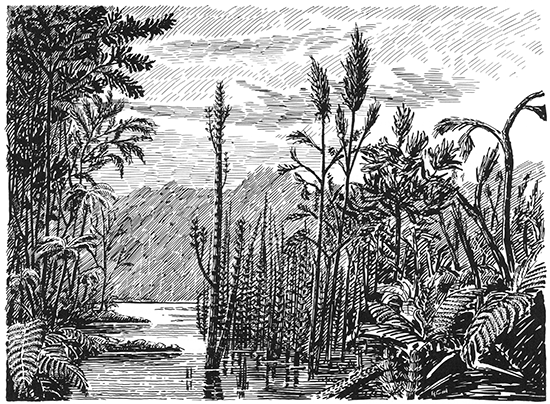
Kansas coal is mainly bituminous and is found in the eastern third of the state. It has played an important role in Kansas economy and has been mined in Anderson, Atchison, Bourbon, Brown, Cherokee, Coffey, Crawford, Chautauqua, Doniphan, Douglas, Elk, Franklin, Geary, Jackson, Jefferson, Labette, Leavenworth, Linn, Lyon, Montgomery, Nemaha, Neosho, Osage, Shawnee, Wabaunsee, and Wilson counties. Most of it originated during the Pennsylvanian Period, sometimes referred to as the "Great Coal Age," but a few beds are in Permian rocks. Originally this coal was probably vegetation in freshwater swamps similar to those found on parts of the Atlantic coast today. After the plants died and were buried under muds and sands, they began to decay. The first stage in the formation of coal is the development of peat. The passing of geologic time changes peat into lignite, or "brown coal," and eventually into bituminous coal. Had Kansas coal undergone even more heat and pressure than it has, it might have become anthracite.
"Brown coal" (lignite) is found in Kansas in younger rocks of Cretaceous age. Small quantities occur in the Dakota Formation in Clay, Cloud, Dickinson, Ellsworth, Ford, Hodgeman, Jewell, Lincoln, Mitchell, Republic, Russell, Washington, and perhaps a few other counties. Lignite coal, woody in appearance, is intermediate in quality between peat and bituminous coal. Its water content is as much as 40%, and when exposed to air it dries out and crumbles.
Coal Sample from Southeastern Kansas.
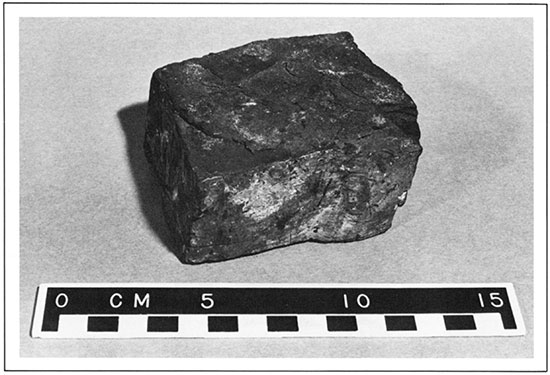
Petroleum and natural gas
Petroleum is an oily liquid consisting of many compounds of hydrogen and carbon. Most of it is found by drilling to subsurface deposits in rock formations. Rarely, some may be seen oozing from cracks in rocks or floating on the surface of water. Oil seeps have been reported in southeastern Kansas and a few other places where oil coverings have been found on the surface of water in wells and ponds.
Oil, like coal, is formed from the remains of living organisms. It is formed by gradual geothermal "cooking" that transforms the most mobile hydrocarbon chemicals over a few million years. Unlike coal, however, oil usually moves from the source rock to a "reservoir rock" after its formation. For example, geologists theorize that much of the oil in central Kansas was formed in Oklahoma and migrated north, where it was trapped. Oil in the reservoir rock occurs in the pore spaces in limestone or dolomite or between sand grains; it is not found in underground pools or lakes. Oil wells are drilled with the hope of finding a porous reservoir rock containing a commercial accumulation of oil. Kansas has produced oil since the 1860's, and regularly ranks among the leading states in the nation in terms of oil production and exploration.
Kansas oil production began in southeastern Kansas where oil was produced from shallow rocks of Pennsylvanian age. In the early 1900's, however, oil was discovered near El Dorado, kicking off one of the biggest oil booms in the history of the state. In 1918, the El Dorado field alone produced an estimated 6% of all oil pumped in the United States. By the 1920's and 1930's, exploration had moved west, concentrating on fields along the Central Kansas uplift, a buried arch of rocks that extends from central Kansas to the northwest. Counties near that feature such as Ellis and Russell are still the leading oil producers in the state.
Natural gas is associated with oil in most oil fields. In some places--such as the Hugoton Gas Area, one of the world's largest gas fields (Finney, Grant, Hamilton, Haskell, Kearny, Morton, Seward, Stanton, and Stevens counties)--natural gas occurs in huge quantities.
Comanche County Oil Well.
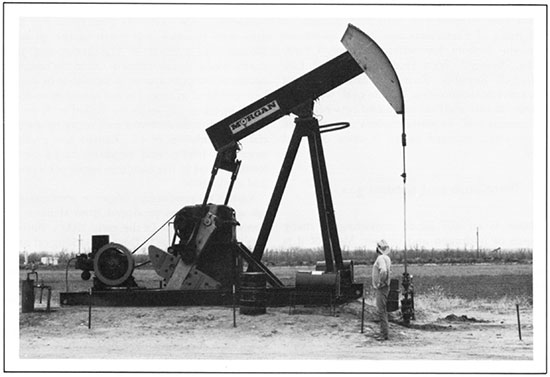
Oil shale
Oil shale is a compact, laminated, sedimentary rock containing a large amount of organic matter that can yield oil when distilled. The organic matter came from partially decomposed algae and animals. Oil shales are an important source of oil in parts of Europe, but deposits in the United States may be regarded as a reserve supply for future needs.
Deposits of black oil shale are found in Labette, Crawford, Bourbon, Douglas, Linn, Neosho, Wallace, and Franklin counties. They occur in Pennsylvanian shales in the eastern counties and in Cretaceous shales in western Kansas.
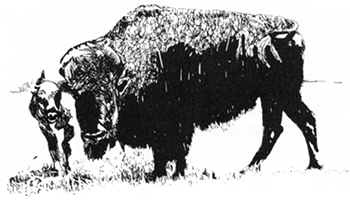
Prev Page--Geologic History || Next Page--Minerals
Kansas Geological Survey
Placed on web Feb. 28, 2017; originally revised and reprinted 1998.
Comments to webadmin@kgs.ku.edu
The URL for this page is http://www.kgs.ku.edu/Publications/Bulletins/ED2/03_rocks.html